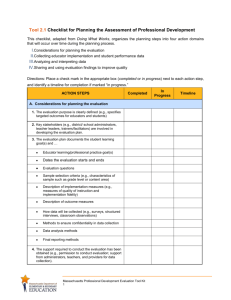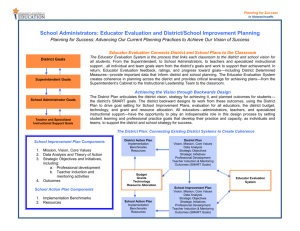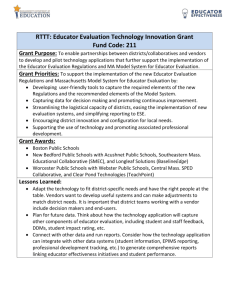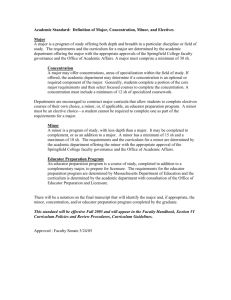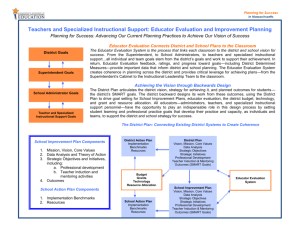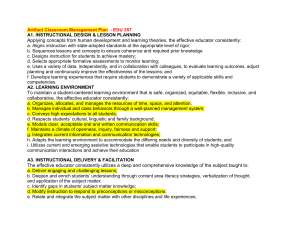Superintendents: Educator Evaluation and District Planning
advertisement
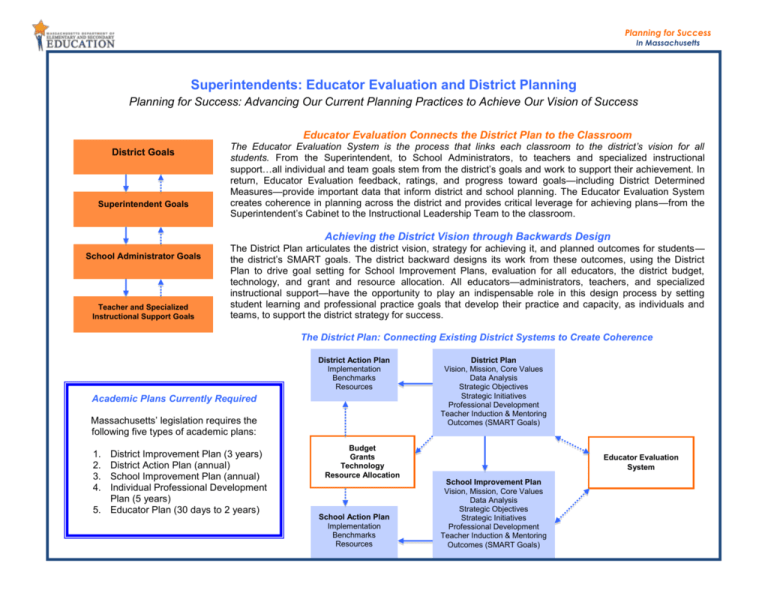
Planning for Success In Massachusetts Superintendents: Educator Evaluation and District Planning Planning for Success: Advancing Our Current Planning Practices to Achieve Our Vision of Success Educator Evaluation Connects the District Plan to the Classroom District Goals Superintendent Goals The Educator Evaluation System is the process that links each classroom to the district’s vision for all students. From the Superintendent, to School Administrators, to teachers and specialized instructional support…all individual and team goals stem from the district’s goals and work to support their achievement. In return, Educator Evaluation feedback, ratings, and progress toward goals—including District Determined Measures—provide important data that inform district and school planning. The Educator Evaluation System creates coherence in planning across the district and provides critical leverage for achieving plans—from the Superintendent’s Cabinet to the Instructional Leadership Team to the classroom. Achieving the District Vision through Backwards Design School Administrator Goals Teacher and Specialized Instructional Support Goals The District Plan articulates the district vision, strategy for achieving it, and planned outcomes for students— the district’s SMART goals. The district backward designs its work from these outcomes, using the District Plan to drive goal setting for School Improvement Plans, evaluation for all educators, the district budget, technology, and grant and resource allocation. All educators—administrators, teachers, and specialized instructional support—have the opportunity to play an indispensable role in this design process by setting student learning and professional practice goals that develop their practice and capacity, as individuals and teams, to support the district strategy for success. The District Plan: Connecting Existing District Systems to Create Coherence District Action Plan Implementation Benchmarks Resources Academic Plans Currently Required Massachusetts’ legislation requires the following five types of academic plans: 1. 2. 3. 4. District Improvement Plan (3 years) District Action Plan (annual) School Improvement Plan (annual) Individual Professional Development Plan (5 years) 5. Educator Plan (30 days to 2 years) Budget Grants Technology Resource Allocation School Action Plan Implementation Benchmarks Resources District Plan Vision, Mission, Core Values Data Analysis Strategic Objectives Strategic Initiatives Professional Development Teacher Induction & Mentoring Outcomes (SMART Goals) Educator Evaluation System School Improvement Plan Vision, Mission, Core Values Data Analysis Strategic Objectives Strategic Initiatives Professional Development Teacher Induction & Mentoring Outcomes (SMART Goals) Planning for Success In Massachusetts Educator Evaluation Expectations for Superintendents: District Planning What are the planning-related behaviors identified in the Educator Evaluation rubric for Superintendents? What are the practices of effective districts in relation to district planning and implementation? The Educator Evaluation System identifies planning-related behaviors for at least 10 indicators, including four indicators for Standard 1, Instructional Leadership. The table below presents key behaviors as defined by the Superintendent rubric, and the planning-related characteristics of effective districts as defined by the District Standards and Indicators. The District Standards and Indicators is the research-based framework used to evaluate districts during the District Review process. Citations are included for all indicators. District Plan Components Mission, Vision, Core Values Data Analysis, Theory of Action Strategic Objectives, Strategic Initiatives Outcomes What Proficient Superintendents Do (Educator Evaluation Rubric) Develops, promotes, and models commitment to core values that guide development of a succinct, results-oriented mission statement and ongoing decision making (IV-A2) At all grade levels, continuously engages administrators, staff, students, families, and community members in developing a vision focused on student preparation for college and career readiness, civic engagement, community contributions (IV-E-1) Guides administrators and supports them in identifying a range of appropriate data sources and effectively analyze the data for decision making purposes (I-E-1) Ensures that administrators use data, research, and best practices to adapt practice to achieve improved results (IV-D-1) Uses multiple data sources to evaluate administrator and district performance. Provides administrators and administrator teams with the resources and support to disaggregate assessment data and assists them in identifying students who need additional support (I-E-3) Uses data to accurately assess school and district strengths and areas of improvement to inform the creation of focused, measurable district goals. Provides support to principals in their efforts to create focused, measurable school goals (I-E-2) Develops district-wide induction support for new administrators and teachers and/or faithfully implements the district’s induction strategy; organizes high quality jobembedded professional development aligned with district goals; and supports the career growth of effective professional personnel by distributing leadership tasks, developing criteria for the awarding of professional status, and monitoring progress and development (II-B-2) Builds consensus within the school district community around critical school decisions, employing a variety of strategies (IV-F-3) Develops a budget that aligns with the district’s vision, mission, and goals. Allocates and manages expenditures consistent with district/school-level goals and available resources (II-E-1) Support administrators and administrator teams to develop and attain meaningful, actionable, and measurable professional practice, student learning, and where appropriate, district/school improvement goals (I-D-1) What Effective Districts Look Like (District Standards and Indicators, District Review Protocol 2014) The district and school leaders have a well-understood vision or mission, goals, and priorities for action that are outlined in a District Improvement Plan (Leadership 3) The plan’s performance goals for students and its analysis of student achievement data drive the development, implementation and modification of educational programs (Leadership 3) District and school leadership annually review student assessment results, student growth data, external and internal reviews, and other pertinent data to prioritize goals, maximize effectiveness in allocating human and financial resources, and to initiate, modify, or discontinue programs and services (Assessment 2) District and school plans are developed and refined through an iterative process that includes input from staff, families, and partners on district goals, initiatives, policies, and programs (Leadership 3) Professional development, training, and technical assistance are based on district priorities, educator data, student learning data, and assessments of instructional practices and programs at each school (Human Resources 3) The district effectively allocates its resources to directly support district goals in order to promote student achievement (Finance 3) The superintendent annually recommends to the school committee educationally sound budgets based primarily on its improvement planning and analysis of data (Leadership 4) District and school leaders monitor student achievement, educator practice, and financial/resource data throughout the year in order to ascertain progress towards goals…(Assessment 2)

